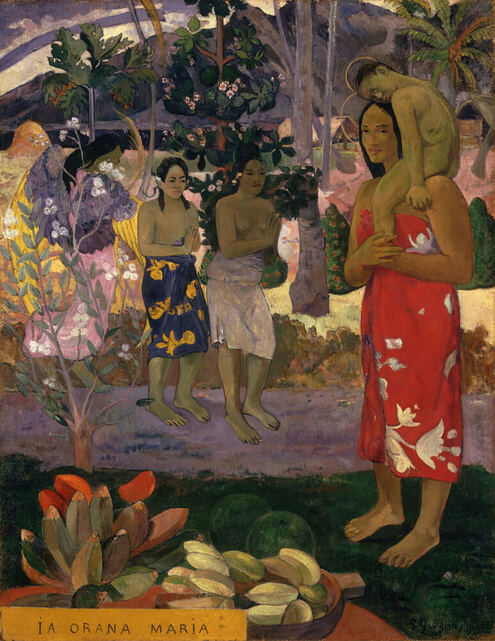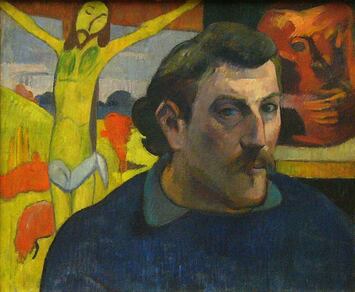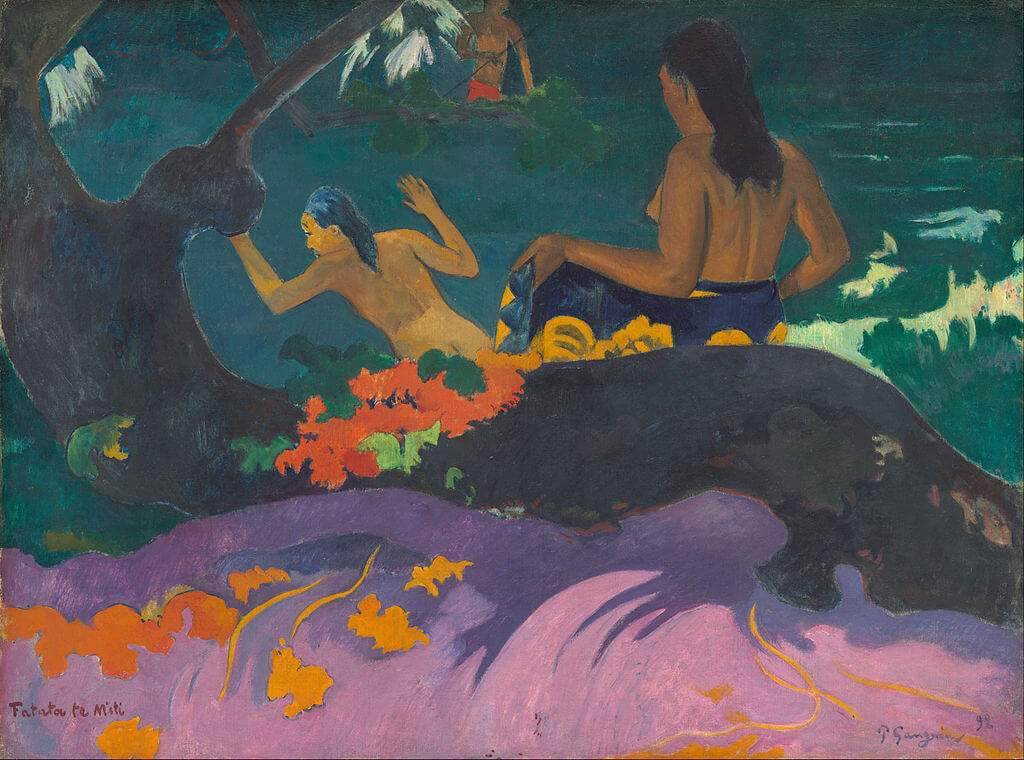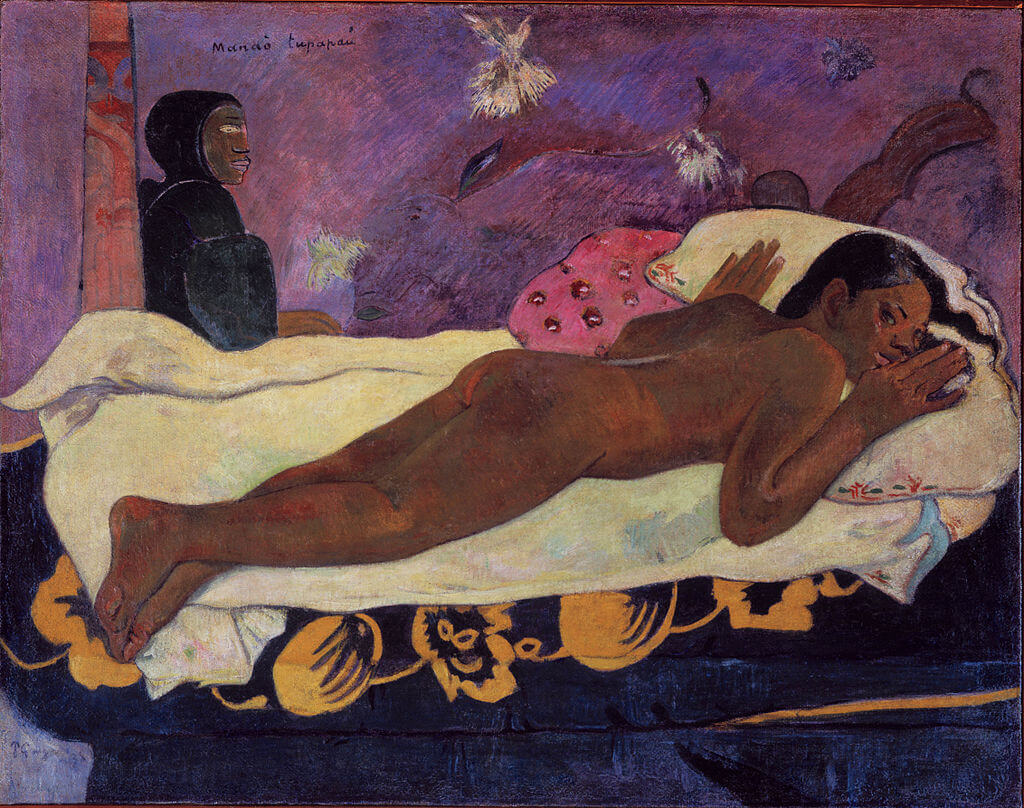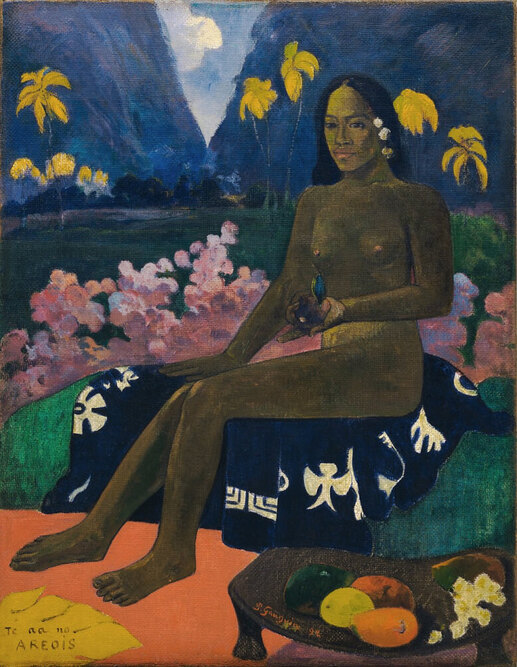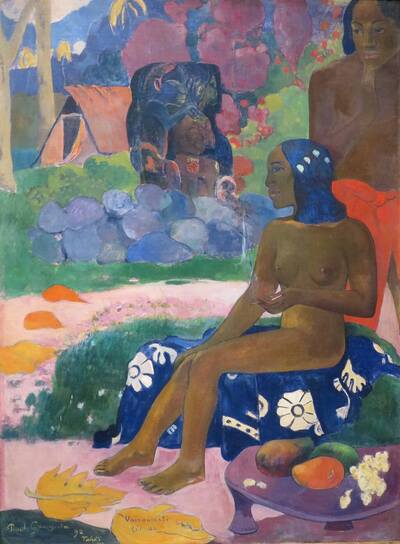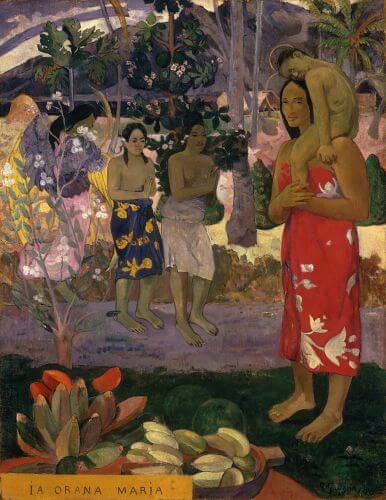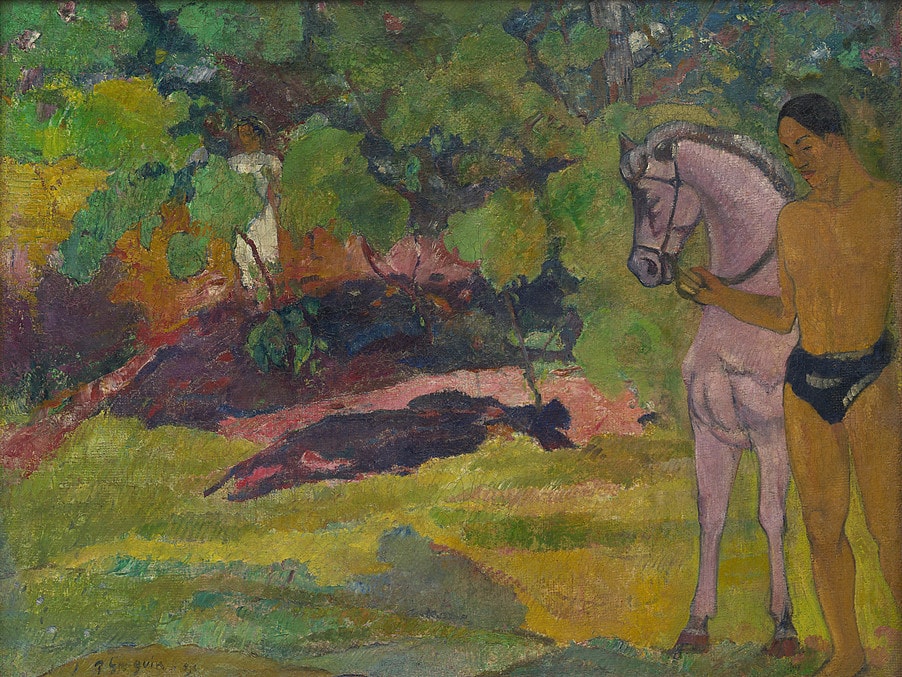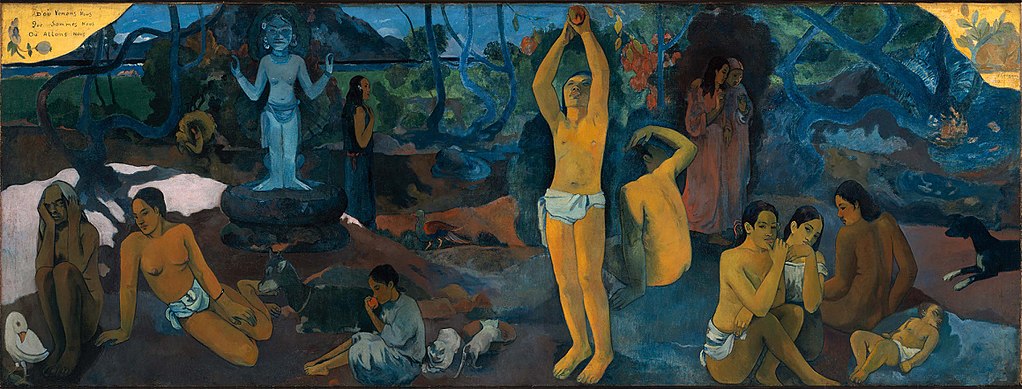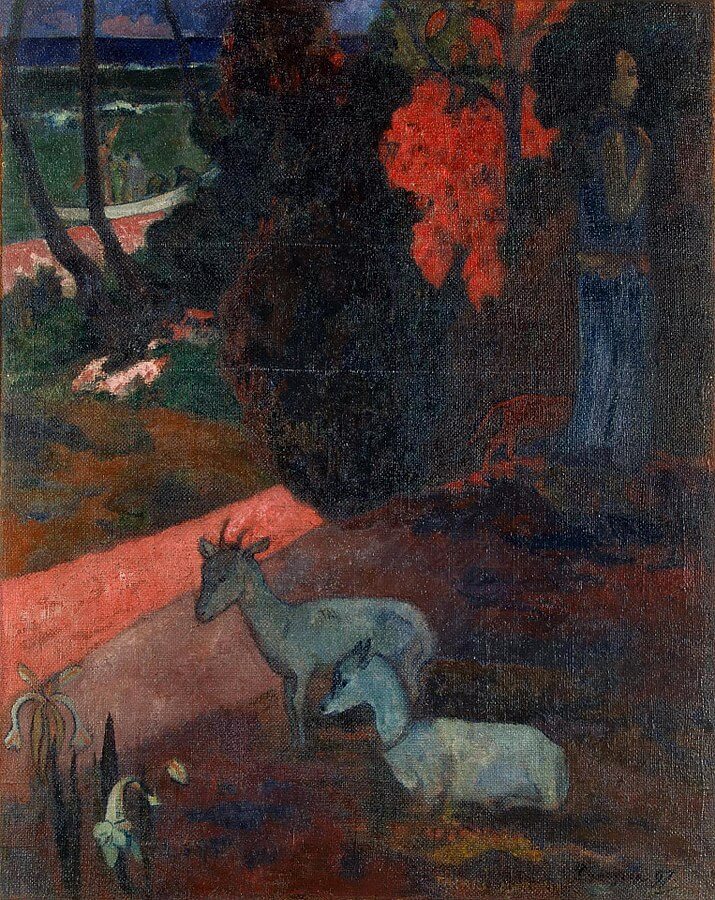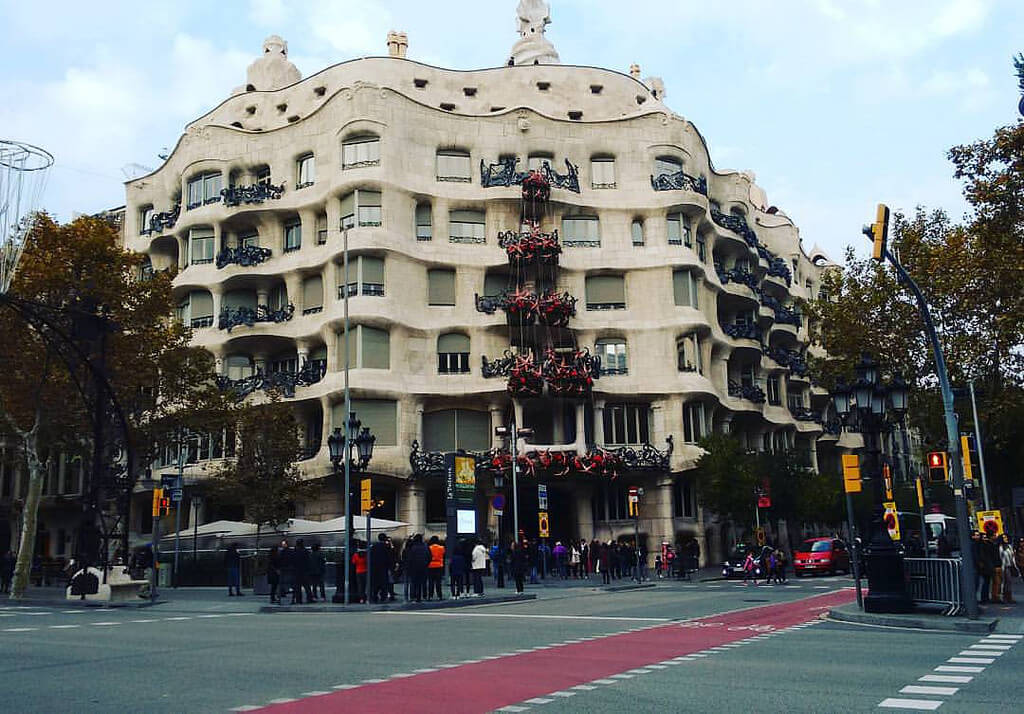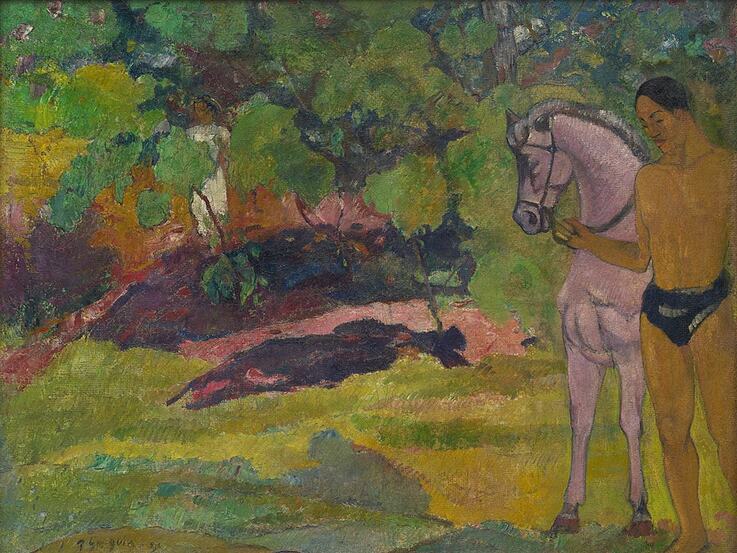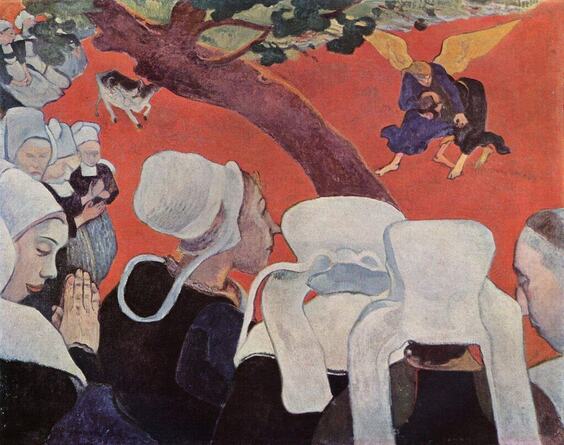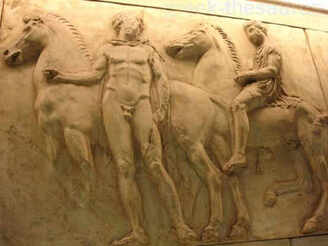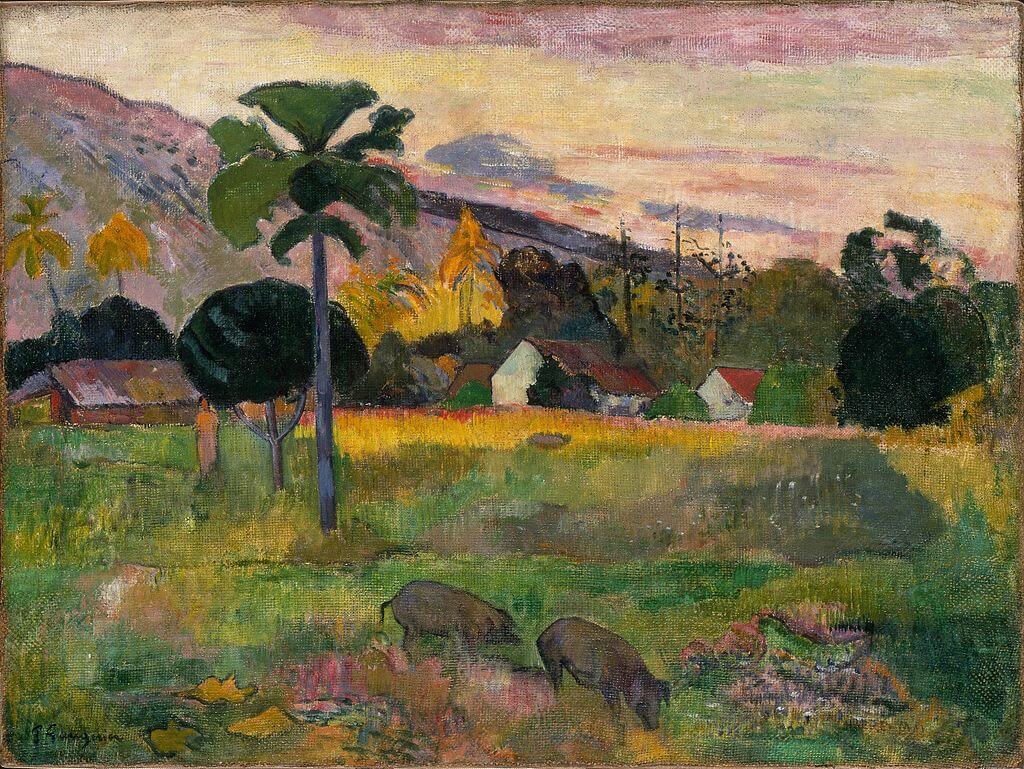|
Where? Gallery 825 of the Metropolitan Museum of Art
When? 1891 What do you see? This painting contains five people. On the right is Mary with her naked child Jesus sitting in an odd pose on her shoulder. Both have a halo around their head and are looking at the viewer. Mary is wearing a red pareo (which is a dress that is wrapped around the middle or higher and is typical for people in Tahiti and the Cook Islands) wrapped around her with a hibiscus flower motif on it. On the left, you can see a female angel (probably representing the Archangel Gabriel) dressed in pink and with blue and yellow wings. The angel is partly hidden behind a flowering tree. The angel points out the presence of Mary and Jesus to the two Tahitian women on the purple path. These two women are dressed in a pareo from the waist down, and they fold their hands in devotion. In the foreground is a collection of fruit laying on a fata, which is a wooden altar that Polynesians use to make offers to their gods. These fruits may be an analogy to the gifts that the three Magi brought to Jesus after his birth. The fruit includes red and yellow Tahitian bananas (some of which are in a wooden bowl) and the green breadfruit in the center. In the background, you can see the dark mountains, a lake, palm trees, and flowering bushes. There is a boathouse on the right side of the lake.
What is Hail Mary? Also known as the Angelic Salutation or Ave Maria, Hail Mary is a prayer in the Catholic Church. The full text of this prayer is:
“Hail Mary, full of grace, the Lord is with thee. Blessed art thou amongst women and blessed is the fruit of thy womb, Jesus. Holy Mary, Mother of God, pray for us sinners, now, and in the hour of our death. Amen.” This prayer is the most popular prayer aimed at Mary and asks for her help in intervening between the person praying and God. Who is Gauguin? Eugène Henri Paul Gauguin (1848-1903) is a Post-Impressionist artist who is known for his experimental use of colors. Vincent van Gogh and Edgar Degas were important for Gauguin in developing his unique style. In 1891, Gauguin moved to Tahiti to start a new life. His idea was to set up a community of painters, called l’atelier des tropiques in an area that was far away from home and did not suffer from the materialism that was present in France. The main idea behind this initiative was to stimulate the role of spirituality in their artworks and to expose themselves to different cultures and religions. In the end, no other painters joined him, and he left alone to Tahiti. However, this did not have a negative effect on the quality of Gauguin’s work, and he produced some of his best works during this period, including By the Sea (Fatata te Miti) in the National Gallery of Art and Spirit of the Dead Watching (Manao Tupapau) in the Albright–Knox Art Gallery in Buffalo. Most of Gauguin’s paintings are based on his imagination, and he expressed in a letter to his wife that he believed that his artistic center was in his mind and did not need to be inspired by other painters.
Fun fact: Gauguin did not have any models from Tahiti in front of him to paint this picture, but rather painted this based on his imagination and some other stimuli that he brought to Tahiti. For example, as Tahitians were not walking around half-naked, the two women in the middle are modeled after the figures of dancers on a bas-relief of the Javanese Borobudur temple of which he had brought a picture. Also, the pose of Jesus on top of Mary’s shoulder was based on a postcard that Gauguin bought during his trip to Tahiti. Moreover, Gauguin was one of the first artists to depict Mary and Jesus with a colored skin, something that was not allowed yet by the Catholic Church.
0 Comments
Where? In the Museum of Modern Art, but currently not on display.
When? 1892 What do you see? A nude girl from Tahiti sits on a blue and white blanket. She is sitting in a dignified position with her back very straight, like the old Egyptians depicted people in art. She has some white flowers in her hair and in her left hand she holds a flowering mango (seed) that she seems to offer to the viewer. This flowering mango symbolizes fertility and was the sacred fruit of the Areoi society. On the bottom right is a three-legged table (called an umete in Polynesian) with more mangos in different colors. The girl is sitting against a background of pink flowers. In the background is the beautiful landscape of Tahiti which shows some mountains, water, trees, and a piece of the sky. Gauguin kept this painting relatively simple and did, for example, not include any shadows. He created a very colorful painting where the colors are not all very realistic. Backstory: This painting is also known under the Polynesian title Te Aa No Areois as can be seen in the bottom left corner. The painting was bought in 1936 by William S. Paley, a trustee, and the later president of the Museum of Modern Art. It was the first Gauguin painting acquired by the MoMA. Gauguin signed and dated the painting on the left side of the table with fruit in the foreground. The composition of the painting is similar to another Gauguin painting entitled Her Name is Vaïraümati (or Vairaumati Tei Oa) which is in the Pushkin Museum in Moscow. This painting deals with a similar theme, which is the origin of the Areoi society.
Who are the Areoi? Also referred to as the Arioi, it is a secret religious society in French Polynesia which does not exist anymore. At its origin is a myth about the god Oro who has intercourse with the most beautiful woman on earth, Vaïraümati, which results in the creation of a new race. The society had a hierarchical structure with several classes or ranks. While everyone, both men and women, could theoretically enter into each class within the Areoi, the highest classes were in practice mainly accessible for people from the higher classes of society. The highest class was reserved for priests.
Access to the society depended on your beauty, religious knowledge, recitation skills, and dancing skills. Moving up through the ranks was confirmed by increasingly large tattoos. Members of the society had sexual freedom until they married and were not allowed to get children. Most of the French Polynesian islands had their Areoi order, and they all had a place of worship and several houses in which the members met and where members of the other islands could stay. Who is Gauguin? Eugène Henri Paul Gauguin (1848-1903) was a Post-Impressionist artist from Paris. He was a self-taught painter without any formal education. He spent a large time of his youth in Peru where he developed his taste for traveling and exotic countries. In 1891, he moved to Tahiti in French Polynesia where he stayed until 1893 when he temporarily moved back to France. In 1895, he returned to Tahiti where he spent most of his time until his death in 1903. Gauguin is widely known for the idyllic and colorful paintings he made in French Polynesia. His work has had a big influence on artists such as Henri Matisse and Pablo Picasso. Other well-known works of Gauguin from his first period in French Polynesia are Hail Mary in the Metropolitan Museum of Art and In the Vanilla Grove, Man and Horse in the Guggenheim Museum in New York.
Fun fact: The girl in this painting is the Tahitian mistress/wife of Gauguin. Her name is Tehura, and she is 13 years old at the time of this painting. Soon after this painting, she was pregnant. She is depicted as Vaïraümati, the wife of the god Oro, who gave birth to a son who formed the beginning of the Areoi.
Gauguin wanted to paint the origins of this secret society which he claimed to have learned from Tehura. However, it is now assumed that Gauguin learned about this society through a travel book by Jacques-Antoine Moerenhout. In fact, Tehura was not aware at first that she was depicted as the mother of the Areoi. Interested in a copy for yourself? Poster of canvas.
Where? Gallery 255 of the Museum of Fine Arts
When? 1897-1898 What do you see? This painting shows a story on the cycle of life. It consists of three parts corresponding to the three questions in the title of the painting.
Backstory: The French title of this painting is D'où Venons Nous? Que Sommes Nous? Où Allons Nous? Gauguin included this title on the top left of the painting. A valuable source of information to understand this painting are the letters that Gauguin wrote to George-Daniel de Monfreid, an art collector and painter in France. Based on these letters, we know that when Gauguin started to work on this painting, he was in a dark period of this life. He faced quite some debt, bad health, the death of his favorite daughter, and he wanted to kill himself. However, before dying, he wanted to complete a large canvas about the meaning of life. For about one month, he worked day and night on the painting. When it was finished, he considered this to be his best work ever and wrote that he would never make a better painting. Some other works that he completed during this dark period of his life are the Landscape with Two Goats (also known as Tarari Maruru) and Man Picking Fruit from a Tree. After Gauguin completed the Where Do We Come From painting, he attempted suicide but failed at it. The painting was exhibited in 1898 in Paris and received mixed reviews. In 1901, the painting was sold for 2500 French Francs (which is equivalent to about $15,000 today).
Who is Gauguin? Eugène Henri Paul Gauguin was born in 1848 in Paris, France, and died in 1903 in French Polynesia. Gauguin is considered to be a Post-Impressionist artist, though his work differs from the Post-impressionists by the unique colors that he used and the feelings he expressed in his paintings. Just like paintings by Van Gogh, who was a friend of Gauguin, the works of Gauguin are often recognizable from a distance.
Gauguin was only a full-time artist during the last 20 years of his life. Until the crash of the French stock market and the art market in 1882, Gauguin was a successful stock and art broker, yearly making the equivalent of about $250,000 today. In 1891, he decided to move to Tahiti in French Polynesia where he stayed for two years. Upon his arrival, he created some of his famous paintings, like Hail Mary in the Metropolitan Museum of Art and In the Vanilla Grove, Man and Horse in the Guggenheim Museum in New York. After an unsuccessful return to France for two years, Gauguin returned to French Polynesia where he lived until his death.
Fun fact: This painting is featured in the book Origin (Amazon Link) by Dan Brown. In the book, the painting hangs in Casa Mila in Barcelona, which was a private house designed by Antoni Gaudí. The painting refers to the search for the existential questions of ‘where do we come from?’ and ‘where are we going?’. The painting by Gauguin does not answer these questions.
Gauguin kept the painting and symbolism in this painting quite vague to stimulate the viewer to think about these questions. That has certainly worked for some people in Dan Brown’s book as some characters are actively looking for the answers to these questions.
Where? Part of the Thannhauser collection of the Solomon R. Guggenheim Museum
When? 1891 What do you see? This painting is situated in a small forest in Tahiti used to grow vanilla. The vanilla vines climb up the trees. The majority of the painting is made up by the landscape. In the bottom half of the painting, Gauguin used abstract color areas to depict the grassland. The forest in the background looks more like a tapestry. In the right foreground, a man holding his horse can be seen. The man is only wearing black shorts. He is looking down while waiting and does not have much expression on his face. In between the trees, just left to the middle, a woman dressed in white hides in the forest. It seems that the two people have arranged a romantic meeting (a rendezvous) between them that needs to remain a secret.
Synthetism: This is an artistic style used by artists such as Gauguin and Émile Bernard. It is a combination of different approaches to painting. For example, on the one hand, the real world can be depicted in a painting, while, on the other hand, the artist’s dream world can also be depicted.
As Gauguin was an artist who mainly painted from his imagination, he combined the real world which he saw in front of him with the ideas that he had in his mind. In this painting, he combined the landscape in French Polynesia with a scene in his mind from a man with a horse that was inspired by one of the friezes of the Parthenon. An even better example of this style is the painting Vision after a Sermon by Gauguin. In this painting, several women are leaving the church at the bottom, and they see a vision of Jacob wrestling with the Angel, which was the subject of the sermon.
Who is Gauguin? Eugène Henri Paul Gauguin (1848-1903) was born in Paris. He was a Post-Impressionist painter. He is known for his experimental use of different colors, which has had a big impact on future artists such as Picasso and Matisse.
On April 1, 1891, Gauguin left to Tahiti, which is the largest island of French Polynesia and lies in the middle of the Pacific Ocean. His idea was to escape from the artificial life in France and to immerse in nature, live like a child would do, and focus on his art. The first painting he created on Tahiti is Hail Mary which is now on display in the Metropolitan Museum of Art. At the same time as the painting In the Vanilla Grove, Man and Horse, he also painted Haere Mai, which is also on display at the Guggenheim Museum. Gauguin stayed in Tahiti for two years, before returning to France in August 1893. In 1895, he returned to French Polynesia where he stayed until his death. During his life, Gauguin was often struggling for enough money to be a full-time painter, but his work became very popular after his death.
Tahiti: Tahiti is an island in the middle of the Pacific Ocean. It is formed by volcanic activity and is a part of France. 70% of the total population (which is less than 200,000) consists of indigenous Tahitians. While many people speak the Tahitian language, French is the official language. The island contains a small airport but has direct flights to Los Angeles, Paris, Sydney, and Tokyo. Vanilla is one of the important export products of Tahiti. The island contains a small museum dedicated to Gauguin, appropriately called the Paul Gauguin Museum.
Fun fact: In 1893, Gauguin returned to Paris to sell some of his paintings. During his time there he dressed in traditional Polynesian cloths and started an affair with an exotic teenager. His stay in France was not a success, and his ideas and his reputation were verbally attacked in the Mercure de France magazine by several contemporaries. Disappointed, he returned in 1895 to French Polynesia, where he could focus again on his art without much distraction from the artificial and conventional aspects of life.
Written by Eelco Kappe
|
Categories
All
|
- Home
- Blog
-
Museums
- Alte Pinakothek
- Art Institute of Chicago
- Baltimore Museum of Art
- Barber Institute of Fine Arts
- Bargello
- Barnes Foundation
- British Museum
- Church of Sant’Anastasia
- Cleveland Museum of Art
- Courtauld Institute of Art
- Detroit Institute of Arts
- Frans Hals Museum
- Galleria Borghese
- Gallerie dell'Accademia
- Getty Museum
- Guggenheim
- Hermitage Museum
- Kunsthistorisches Museum
- Kunstmuseum Basel
- Legion of Honor Museum
- Louvre
- Mauritshuis
- Metropolitan Museum of Art
- Musee d’Orsay
- Museum of Fine Arts in Boston
- Museum of Modern Art
- National Gallery in London
- National Gallery of Art
- National Museum in Poznań
- Norton Simon Museum
- Ny Carlsberg Glyptotek
- Palace of Versailles
- Palazzo Pitti
- Palazzo Vecchio
- Petit Palais
- Philadelphia Museum of Art
- Prado
- Pushkin Museum
- Ravenna Art Museum
- Rijksmuseum
- San Diego Museum of Art
- Santa Maria delle Grazie
- St. Peter's Basilica
- Städel Museum
- Statens Museum for Kunst
- Tate Britain
- Tate Modern
- Timken Museum of Art
- Uffizi
- Vatican Museums
- Wallace Collection
-
Artists
- Altdorfer
- Anguissola
- Berlin Painter
- Bosch
- Botticelli
- Boucher
- Bronzino
- Bruegel the Elder
- Brunelleschi
- Cabanel
- Caillebotte
- Canova
- Caravaggio
- Carpeaux
- Cezanne
- Cimabue
- David
- Degas
- Delacroix
- De Maria
- Donatello
- El Greco
- Fontana
- Fra Angelico
- Fragonard
- Gauguin
- Gentileschi
- Gericault
- Gonzalez-Torres
- Goya
- Hals
- Hogarth
- Hokusai
- Ingres
- Leonardo da Vinci
- Lippi, Filippo
- Longhi, Barbara
- Lorrain
- Makovsky
- Manet
- Massys
- Matisse
- Merian
- Michelangelo
- Mochi
- Modigliani
- Monet
- Panini
- Parmigianino
- Perugino
- Picasso
- Pisanello
- Raphael
- Rembrandt
- Renoir
- Reynolds
- Rivera
- Rodin
- Rubens
- Scultori
- Seurat
- Steen
- Tintoretto
- Titian
- Toulouse-Lautrec
- Turner
- Uccello
- Van der Weyden
- Van Dyck
- Van Eyck
- Van Gogh
- Van Hemessen
- Vasari
- Velazquez
- Vermeer
- Veronese
- Vigée Le Brun
-
Locations
- Books
- About Us

